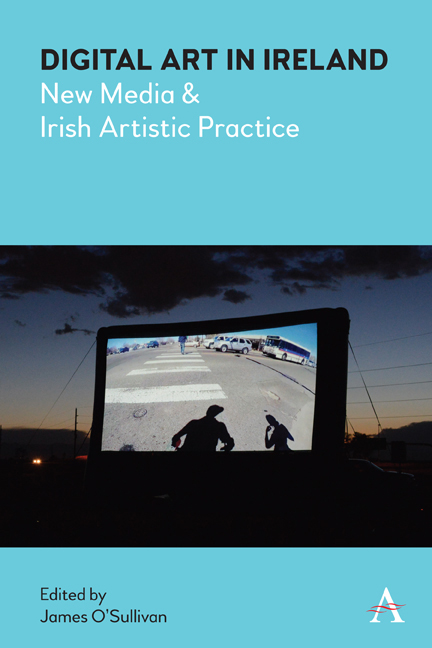Book contents
- Frontmatter
- Dedication
- Contents
- List of Illustrations
- Acknowledgements
- Notes on Contributors
- Chapter 1 Introduction: Digital Art in Ireland
- Chapter 2 Strange Mothers: The Maternal and Contemporary Media Art in Ireland
- Chapter 3 Between Aesthetics and Institutions: Irish Electronic Poetry
- Chapter 4 ‘to shine upon the original all the more fully’: Contemporary New Media Adaptations of James Joyce
- Chapter 5 Art in the Data-City: Critical Data Art in the Age of Surveillance Capitalism
- Chapter 6 Experimental Arcade Video Games as Self-Reflexive Media Art
- Chapter 7 Folding, Unfolding, Refolding Sound Claire Fitch
- Chapter 8 Treacherous Images and Animal Gazes: Ailbhe Ní Bhriain's Reports to an Academy, 2015
- Chapter 9 Pressing Send: Distribution and Curation in Irish New Media Art
- Index
Chapter 8 - Treacherous Images and Animal Gazes: Ailbhe Ní Bhriain's Reports to an Academy, 2015
Published online by Cambridge University Press: 23 February 2022
- Frontmatter
- Dedication
- Contents
- List of Illustrations
- Acknowledgements
- Notes on Contributors
- Chapter 1 Introduction: Digital Art in Ireland
- Chapter 2 Strange Mothers: The Maternal and Contemporary Media Art in Ireland
- Chapter 3 Between Aesthetics and Institutions: Irish Electronic Poetry
- Chapter 4 ‘to shine upon the original all the more fully’: Contemporary New Media Adaptations of James Joyce
- Chapter 5 Art in the Data-City: Critical Data Art in the Age of Surveillance Capitalism
- Chapter 6 Experimental Arcade Video Games as Self-Reflexive Media Art
- Chapter 7 Folding, Unfolding, Refolding Sound Claire Fitch
- Chapter 8 Treacherous Images and Animal Gazes: Ailbhe Ní Bhriain's Reports to an Academy, 2015
- Chapter 9 Pressing Send: Distribution and Curation in Irish New Media Art
- Index
Summary
Ailbhe Ní Bhriain's multiscreen installation, Reports to an Academy, 2015, is a sequence of four video works shown across three of a room's four walls. The work was first shown at Dublin's Royal Hibernian Academy (RHA) and was originally projected large-scale onto the walls of the darkened gallery space. The installation is composed of four scenes – the shelves of an academic library, a stonewall shot on Inis Oírr, vitrines containing stuffed animals from Dublin's natural history museum, and the white walls of a studio space. (Figure 8.1). These four scenes become cross-sections of a drowned world. In each scene water has risen up to a similar horizon line that reflects the space at the top of the image into the space below. Human life appears to have vacated these visions of a beautiful apocalypse composed of gently rippling water and slow-moving clouds that dreamily float through interior spaces.
Although her work is lens-based, Ailbhe Ní Bhriain's practice has a painterly quality which is untypical of much film/video work. This observation may be attributed to the fact that Ní Bhriain utilises computer-generated imagery and techniques of post-production in order to create hallucinatory spaces that are connected to, but distinct from the real spaces in which the work is shot. This painterly quality is heightened as Ní Bhriain often records stillness in her moving images, as she does in Reports to an Academy, so that the unfolding of time which gives rise to narrative is usurped by a stress on the formal qualities of an image. Ní Bhriain's work also overtly references painterly traditions. Her precise compositions and considered use of colour ensures that attention remains focused on the fact that the videos work, first and foremost, as images. The videos that make up Reports to an Academy announce their status as representations of reality that work against the implied transparency of the medium of film/video. Considering the traditions and conventions of painting with which Ní Bhriain is engaged, this chapter asks if there is something inherent in the medium of the digital image that influences our reading of the work.
- Type
- Chapter
- Information
- Digital Art in IrelandNew Media and Irish Artistic Practice, pp. 121 - 134Publisher: Anthem PressPrint publication year: 2021



